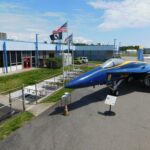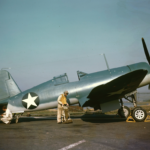During our visit to Sun’ N Fun back in April, we had the opportunity to speak with aircraft restoration expert and pilot John Hess about his rare Beech AT-11 Kansan Tantalizing Takeoff N214CR. The AT-11, as most readers will know, was the U.S. Army Air Forces’ primary bombing trainer during the Second World War; roughly 90 percent of the service’s 45,000+ bombardiers trained on the type. Like the C-45 Expeditor (transport) and the AT-7 Navigator (navigation trainer) variants of the breed, the Kansan derived from the civilian Beechcraft Model 18 commercial transport. Modifications for the AT-11 included a transparent nose, bomb bay, internal bomb racks, and provisions for flexible mounts used in gunnery training.
N214CR served as 41-9486 in the USAAF. She was the 50th AT-11 built and is currently the oldest still flying. The AT-11 was set up as a smaller version of the B-17 Flying Fortress or B-24 Liberator. This provided a simulated training environment similar to the full-sized bombers, but one more economical to operate which also freed up the production line of actual bombers for service at the front lines. The AT-11 used the same C-1 autopilot employed in all U.S. bombers during WWII, tied to the same, top secret Norden bombsight. For gunnery training, the Kansan sported either a dorsal-mounted motor-driven turret with a single .30 caliber machine gun or an equivalent, electrically powered unit with twin .30s. During WWII, Women Airforce Service Pilots, better known as WASPs, were the first women in American history to fly military aircraft on official business. The WASP were stationed and flew AT-11s at Childress and Victorville Army Air Fields during the time this aircraft was assigned to those bases.
History of 41-9486:
- 1941 August – This AT-11 rolled off the assembly line at a contract price of $54,242.00
- 1942 February – Delivered to Victorville Army Airfield Bomb Training School, Victorville, California
- 1944 January – Assigned to Childress AAFLD, Childress, Texas
- 1944 December – Returned to Victorville for the remainder of WWII
- Post WWII – Air Force Reserve, Birmingham, Alabama. Troop Carrier Wings, Miami, Florida and Memphis, Tennessee
- 2011 – Purchased by current owners Fran Torbett Hess and John Hess
For John Hess, maintaining the eighty-year old airplane is a family business, thanks to the help of his wife Fran and their kids, not to mention a few friends skilled in the arts of fabricating aircraft parts. Their devotion for this timeless beauty keeps her flying in America’s skies. The Hess family and Tantalizing Takeoff are affiliated with the Liberty Foundation, which is currently restoring a C-47 and their storied B-17G, Liberty Belle, which the organization vows will fly again before too long.
For the full interview with John Hess, please see the video below with our own Moreno ‘Mo’ Aguiari leading the discussion in cooperation with Aero-News Network.







![AT-11 Kansan: A Family Affair [VIDEO INTERVIEW] 9 93477404 230252474926662 5757544707014000640 n](https://vintageaviationnews.com/wp-content/uploads/93477404_230252474926662_5757544707014000640_n.jpg)

![AT-11 Kansan: A Family Affair [VIDEO INTERVIEW] 10 93477404 230252474926662 5757544707014000640 n](https://vintageaviationnews.com/wp-content/uploads/93477404_230252474926662_5757544707014000640_n-1024x683.jpg)
![AT-11 Kansan: A Family Affair [VIDEO INTERVIEW] 11 Beechcraft AT](https://vintageaviationnews.com/wp-content/uploads/Beechcraft_AT-11_out_over_the_West_Texas_prairies_00910460_103.jpg)















